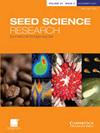黑麦草种子休眠与灌浆期母体环境的关系
IF 2.1
3区 生物学
Q2 PLANT SCIENCES
引用次数: 4
摘要
多年生黑麦草表现出不同程度的种子生理休眠,这取决于种子发育过程中的基因型和环境条件。为了分析灌浆过程中田间温度和降水对PD的影响,在2014年和2015年的五个日期播种了两个品种。收获后,种子PD水平为4–28%。种子发育过程中的高温胁迫(>29°C),以热胁迫单位(HSU)测量,降低了收获时的种子PD(提高了发芽率)。在实验室条件下干燥后熟9个月后,平均休眠种子值从15±8%降低到8±7%。种子PD水平的增加降低了田间幼苗的出苗率。在最佳环境条件下,含20%PD的种子只产生50%的田间出苗率。进行了不同的活力测试,并将每种测试与田间出苗情况进行了比较。通过标准发芽试验第5天的第一次计数,发芽速度和第10天的芽长与田间的幼苗建立更好地相关。HSU有助于在生长季节后在多年生黑麦草种子中建立可能的PD范围。考虑HSU和其他气候参数的模型开发可能会激励未来的研究。本文章由计算机程序翻译,如有差异,请以英文原文为准。
Seed dormancy of Lolium perenne L. related to the maternal environment during seed filling
Abstract Lolium perenne L. (perennial ryegrass) shows variable levels of seed physiological dormancy (PD), which depends on the genotype and environmental condition during seed development. To analyse the effect of field temperature and precipitation during seed filling on the PD, two cultivars were sown on five dates in 2014 and 2015. After harvest, the level of seed PD was 4–28%. High-temperature stress (>29°C) in the field during seed development, measured as heat stress units (HSUs), reduced seed PD (increased germination) at harvest. After 9 months of dry afterripening under laboratory conditions, mean dormant seed values were reduced from 15 ± 8 to 8 ± 7%. An increment in the seed PD level reduced seedling emergence in the field. Seed with 20% PD produced only 50% of field emergence, under optimal environmental conditions. Different vigour tests were conducted and each was compared with field emergence. The speed of germination, through the first count at 5 d of the standard germination test, and the shoot length at 10 d were better associated with the seedling establishment in the field. The HSU could be useful to establish a possible PD range in the seed of perennial ryegrass after the growing season. The development of models considering the HSU and other climatic parameters could motivate future studies.
求助全文
通过发布文献求助,成功后即可免费获取论文全文。
去求助
来源期刊

Seed Science Research
生物-植物科学
CiteScore
3.60
自引率
4.80%
发文量
23
审稿时长
>12 weeks
期刊介绍:
Seed Science Research, the official journal of the International Society for Seed Science, is a leading international journal featuring high-quality original papers and review articles on the fundamental aspects of seed science, reviewed by internationally distinguished editors. The emphasis is on the physiology, biochemistry, molecular biology and ecology of seeds.
 求助内容:
求助内容: 应助结果提醒方式:
应助结果提醒方式:


